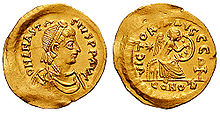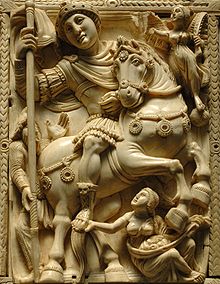- Anastasius I (emperor)
-
Anastasius I Emperor of the Byzantine Empire 
Semissis of Emperor Anastasius.Reign 11 April 491 – 9 July 518 Full name Flavius Anastasius Augustus Titles Consul of the Roman Empire Born c. 430 Birthplace Dyrrhachium, modern Durrës in Albania Died 9 July 518 (aged 88) Place of death Constantinople Predecessor Zeno Successor Justin I Consort Ariadne Dynasty Leonid Dynasty Anastasius I (Latin: Flavius Anastasius Augustus, Greek: Ἀναστάσιος; c. 430 – July 518) was Byzantine Emperor from 491 to 518. During his reign the Roman eastern frontier underwent extensive re-fortification, including the construction of Dara, a stronghold intended to counter the Persian fortress of Nisibis.
Contents
Background and personal characteristics
Anastasius was born at Dyrrhachium; the date is unknown, but he is thought to have been born no later than 430 or 431. He was born into an Illyrian family,[1] the son of Pompeius (born c. 410), nobleman of Dyrrachium, and wife Anastasia Constantina (born c. 410). His mother was an Arian, sister of Clearchus, also an Arian, and a paternal granddaughter of Gallus (born c. 370), son of Anastasia (born c. 352) and husband, in turn daughter of Flavius Claudius Constantius Gallus and wife and cousin Constantina.[2]
Anastasius had one eye black and one eye blue (heterochromia),[3] and for that reason he was nicknamed Dicorus (Greek: Δίκορος, "two-pupiled").
Accession
At the time of the death of Zeno (491), Anastasius, a palace official (silentiarius), held a very high character, and was raised to the throne of the Eastern Roman Empire by Ariadne, Zeno's widow, who preferred him to Zeno's brother, Longinus.
Ariadne married him shortly after his accession on 20 May 491. His reign, though afterwards disturbed by foreign and internecine wars and religious distractions, commenced auspiciously. He gained the popular favour by a judicious remission of taxation, and displayed great vigour and energy in administering the affairs of the Empire.
Foreign policy and wars
The principal wars in which Anastasius was engaged were the Isaurian War and the War with Persia.
The former, which lasted from 492 to 497, was stirred up by the supporters of Longinus, the brother of Zeno who had been candidate to his succession against Anastasius. The battle of Cotyaeum in 492 "broke the back" of the revolt, but guerrilla warfare continued in the Isaurian mountains for some years longer.
In the war with Sassanid Persia (502–505), Theodosiopolis and Amida were captured by the enemy, but the Persian provinces also suffered severely and the Byzantines recovered Amida. Both adversaries were exhausted when peace was made (506) on the basis of the status quo. Anastasius afterwards built the strong fortress of Daras to hold in check the Persians in Nisibis. The Balkan provinces however were left denuded of troops and were devastated by invasions of Slavs and Bulgars; to protect Constantinople and its vicinity against them the emperor built the Anastasian Wall, extending from the Propontis to the Euxine.
Domestic and ecclesiastical policies
The Emperor was a convinced Miaphysite, following the teachings of Cyril of Alexandria and Severus of Antioch who taught "One Incarnate Nature of Christ" in an undivided union of the Divine and human natures, but his ecclesiastical policy was moderate; he endeavoured to maintain the principle of the Henotikon of Zeno and the peace of the church. It was rebellious demonstrations of the Byzantine populace, that drove him in 512 to abandon this policy and adopt Miaphysitic programme. His consequent unpopularity in the European provinces was utilized by an ambitious man, named Vitalian, to organize a dangerous rebellion, in which he was assisted by a horde of "Huns" (514–515); it was finally suppressed by a naval victory won by the general Marinus.
Successor
The Anonymous Valesianus tells an account about his choosing of a successor: Anastasius could not decide which of his three nephews should succeed him, so he put a message under a couch and had his nephews take seats in the room, which also had two other seats; he believed that the nephew to sit on the special couch would be his proper heir. However, two of his nephews sat on the same couch, and the one with the concealed message remained empty.
Then, after putting the matter to God in prayer, he determined that the first person to enter his room the next morning should be the next Emperor, and that person was Justin, the chief of his guards. In fact, Anastasius probably never thought of Justin as a successor, but the issue was decided for him after his death. At the end of his reign, he left the Imperial treasury richer by 23,000,000 solidi or 320,000 pounds of gold.[4]
Anastasius died childless in Constantinople on 9 July 518 (some sources say 8 or 10 July) and was buried at the Church of the Holy Apostles.
Family
Anastasius is known to have had a brother named Flavius Paulus, who served as Roman consul in 496.[5] A sister-in-law, known as Magna, was mother to Irene and mother-in-law to Olybrius. This Olybrius was son of Anicia Juliana and Areobindus Dagalaiphus Areobindus.[6] The daughter of Olybrius and Irene was named Proba. She married Probus and was mother to a younger Juliana. This younger Juliana married another Anastasius and was mother of Areobindus, Placidia, and a younger Proba.[7] Another nephew of Anastasius was Flavius Probus, Roman consul in 502.[8] Caesaria, sister of Anastasius, married Secundinus. They were parents to Hypatius and Pompeius.[8] Flavius Anastasius Paulus Probus Moschianus Probus Magnus, Roman Consul in 518 also was a great-nephew of Anastasius. His daughter Juliana later married Marcellus, a brother of Justin II.[7] The extensive family may well have included viable candidates for the throne.[9]
Byzantine Empire coinage reform
The main elements of the complex monetary system of the early Byzantine Empire, which suffered a partial collapse in the 5th century, were revived by Emperor Anastasius I (491–518) in 498. The new system involved three denominations of gold (the solidus and its half and third) and five of copper (the follis, worth 40 nummi and its fractions down to a nummus).
A 40 nummi coin of Anastasius is depicted on the obverse of the Macedonian 50 denars banknote, issued in 1996.[10]
References
- ^ Croke, Brian (2001). Count Marcellinus and his chronicle. Oxford University Press. p. 89. ISBN 9780198150015. http://books.google.com/books?id=ep6U-meRt00C&pg=PA89. Retrieved 12 October 2010.
- ^ Settipani, Christian, Continuite Gentilice et Continuite Familiale Dans Les Familles Senatoriales Romaines, A L'Epoque Imperiale, Mythe et Realite. Linacre, UK: Prosopographica et Genealogica, 2000. ILL. NYPL ASY (Rome) 03-983.
- ^ Anastasius (AD 491–518) Hugh Elton – Florida International University – An Online Encyclopedia of Roman Emperors
- ^ P. Brown, The world of late antiquity, W.W. Norton and Co. 1971 (p 147)
- ^ "The Consular List"
- ^ Late Antiquity: A Guide to the Postclassical World (by G.W. Bowersock, Oleg Grabar). Harvard University Press, 1999. Pages 300–301.
- ^ a b Prosopography of the Later Roman Empire, vol. 3
- ^ a b Prosopography of the Later Roman Empire, vol. 2
- ^ James Allan Evans, "Justin I (518–527 A.D.)"
- ^ National Bank of the Republic of Macedonia. Macedonian currency. Banknotes in circulation: 50 Denars. – Retrieved on 30 March 2009.
- Notes
 This article incorporates text from a publication now in the public domain: Chisholm, Hugh, ed (1911). Encyclopædia Britannica (11th ed.). Cambridge University Press.
This article incorporates text from a publication now in the public domain: Chisholm, Hugh, ed (1911). Encyclopædia Britannica (11th ed.). Cambridge University Press.- Les ancêtres de Charlemagne, 1989
- Continuité gentilice et continuité sénatoriale dans les familles sénatoriales romaines à l'époque impériale, 2000
- Continuité des élites à Byzance durante les siècles obscurs. Les princes caucasiens et l'Empire du VIe au IXe siècle, 2006
External links
 Media related to Anastasius I at Wikimedia CommonsAnastasius I (emperor)Born: c. 430 Died: 9 July 518
Media related to Anastasius I at Wikimedia CommonsAnastasius I (emperor)Born: c. 430 Died: 9 July 518Regnal titles Preceded by
ZenoByzantine Emperor
491–518Succeeded by
Justin IPolitical offices Preceded by
Anicius Olybrius
(alone)Consul of the Roman Empire
492
with Flavius RufusSucceeded by
Flavius Albinus Iunior,
Flavius Eusebius IIPreceded by
Paulus,
Post consulatum Viatoris (West)Consul of the Roman Empire
497Succeeded by
Paulinus,
John the ScythianPreceded by
Flavius Ennodius Messala,
Areobindus Dagalaiphus AreobindusConsul of the Roman Empire
507
with Venantius iunior
Clovis ISucceeded by
Basilius Venantius,
CelerCategories:- House of Leo
- 430 births
- 518 deaths
- 5th-century Byzantine emperors
- 6th-century Byzantine emperors
- Imperial Roman consuls
- Burials at the Church of the Holy Apostles
- Illyrian people
Wikimedia Foundation. 2010.

